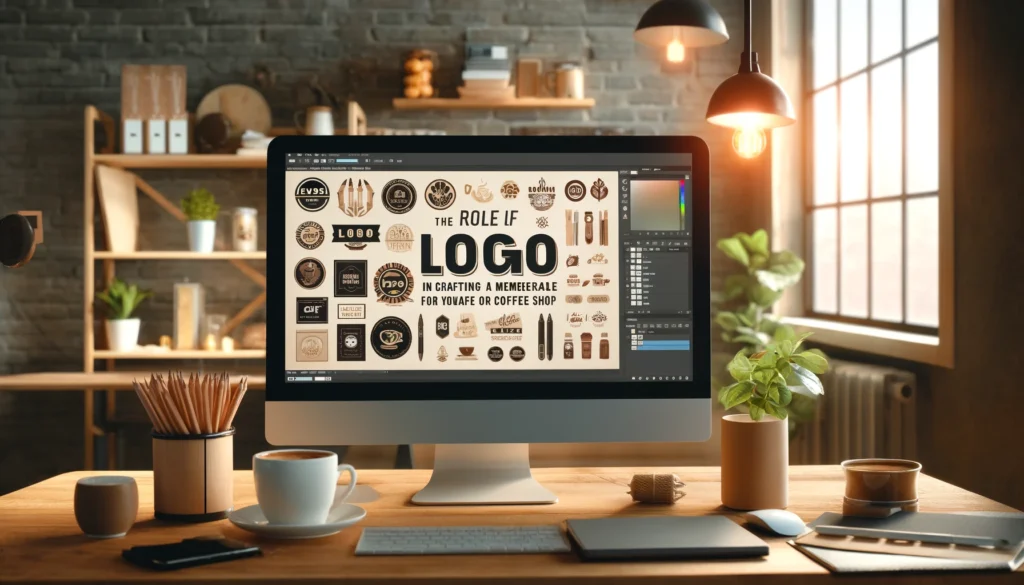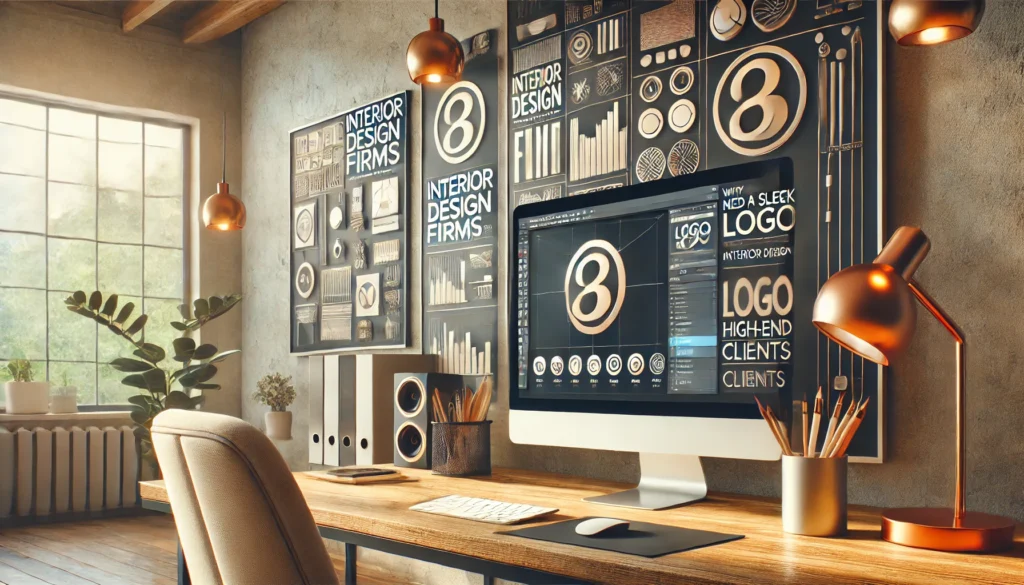







In the world of interior design, where first impressions and aesthetics are paramount, a sleek and sophisticated logo is essential for attracting high-end clients. Your logo is more than just a visual identifier; it’s a representation of your firm’s aesthetic, professionalism, and design philosophy. For interior design firms aiming to work with luxury clientele, a well-designed logo can make a powerful statement, setting the tone for the quality and style of the services you offer. This article explores the importance of a sleek logo for interior design firms, how it can appeal to discerning clients, provides examples of firms with logos that reflect their style, and offers practical tips for creating a logo that aligns with high-end design services.
In the interior design industry, your logo serves as the first point of contact with potential clients, offering a glimpse into your firm’s aesthetic sensibility. A sleek logo that exudes elegance and sophistication instantly communicates that your firm specializes in high-end, luxury designs. The choice of typography, color palette, and design elements should reflect the refined and polished nature of your work. For instance, minimalist designs with clean lines and understated colors often convey a sense of modern sophistication, while more ornate designs might suggest a classic or traditional approach to luxury.
The goal is to ensure that your logo aligns with the aesthetic values of your firm and resonates with clients who are seeking luxurious and meticulously crafted interior spaces. By conveying these qualities through your logo, you establish your firm as a leader in the high-end interior design market.
A logo is a critical component of your brand’s visual identity, and consistency is key to building a strong brand. Whether it’s on your website, business cards, social media profiles, or in print advertisements, your logo should be consistently presented to reinforce your firm’s identity. A sleek and cohesive logo design helps create a unified brand image that is easily recognizable and memorable to clients.
Consistency in your logo design across all platforms not only enhances brand recognition but also builds trust and professionalism. Clients seeking high-end interior design services are often looking for firms that demonstrate attention to detail and a commitment to quality—traits that can be effectively communicated through a consistent and well-crafted logo.
In the luxury market, perceived value and credibility are crucial factors that influence client decisions. A professionally designed logo can significantly enhance the perceived value of your interior design services by conveying a sense of exclusivity, quality, and expertise. A sleek logo suggests that your firm is established, reputable, and capable of delivering high-caliber results, making it more appealing to affluent clients.
Moreover, a strong logo can lend credibility to your brand, reassuring potential clients that your firm is trustworthy and professional. This credibility is particularly important in the interior design industry, where clients are often investing substantial amounts of money and trust into your services. A logo that reflects these qualities can be a powerful tool in attracting and retaining high-end clients.
Clients seeking luxury interior design services are typically discerning and have high expectations when it comes to aesthetics and quality. A sleek and sophisticated logo can attract these clients by reflecting the high-end image they desire. The logo serves as a visual representation of the premium services your firm offers, setting the tone for the entire client experience.
For example, a logo that uses luxurious colors like deep blues, golds, or rich blacks, combined with elegant typography, can evoke a sense of opulence and exclusivity. This not only appeals to clients looking for top-tier design services but also reinforces the idea that your firm is a leader in the luxury interior design market.
A well-designed logo can create an immediate visual connection with your target audience, drawing them in and encouraging them to explore your services further. This connection is particularly important in the luxury market, where clients often make decisions based on emotional appeal and personal resonance. Your logo should reflect the values, aspirations, and tastes of your ideal clients, making them feel that your firm understands and can fulfill their design needs.
For instance, a logo that embodies modern minimalism might appeal to clients looking for contemporary, streamlined designs, while a logo with a more classic or ornate style might attract clients who prefer traditional, elegant interiors. By aligning your logo with the preferences and expectations of your target audience, you increase the likelihood of attracting clients who are a perfect fit for your services.
The interior design industry is highly competitive, with numerous firms vying for the attention of high-end clients. A sleek and distinctive logo can help differentiate your firm from competitors, making it easier for potential clients to remember and choose your services. Your logo should be unique and memorable, standing out in a crowded market while still conveying the sophistication and professionalism that high-end clients expect.
Differentiation can be achieved through various design elements, such as innovative typography, distinctive color combinations, or subtle yet impactful symbols. The key is to create a logo that is not only visually appealing but also reflects the unique qualities and strengths of your firm, setting you apart from others in the industry.
Kelly Wearstler, a renowned interior designer known for her bold and eclectic style, has a logo that perfectly reflects her brand. The logo features her name in a stylish, modern font, with bold, geometric lines that convey a sense of artistry and innovation. The design is both simple and striking, making it instantly recognizable and iconic. This logo aligns with Wearstler’s reputation for creating luxurious, high-impact interiors that are both sophisticated and adventurous.
Yabu Pushelberg, an interior design firm known for its minimalist and modern approach, has a logo that exudes elegance and simplicity. The logo features the firm’s name in a clean, sans-serif font, with a subtle, understated design that reflects the firm’s commitment to modern elegance and refined aesthetics. The minimalist design is versatile and timeless, making it a perfect fit for a firm that values innovation and contemporary style.
Peter Marino, a designer celebrated for his ability to blend traditional craftsmanship with modern innovation, has a logo that captures this unique approach. The logo features Marino’s initials in a classic, serif font, with a bold, modern twist that reflects his ability to bridge the old and the new. The design is both sophisticated and dynamic, making it an excellent representation of Marino’s ability to create luxurious, cutting-edge interiors.
Studio McGee, known for its approachable yet luxurious design style, has a logo that reflects its brand’s timeless appeal. The logo features the studio’s name in a simple, elegant font, with a clean, modern design that conveys both sophistication and accessibility. The use of neutral colors and classic typography makes the logo versatile and easy to recognize, aligning with the brand’s mission to create beautiful, livable spaces that combine high-end design with everyday comfort.
Before you begin designing your logo, it’s essential to have a clear understanding of your firm’s unique aesthetic and values. Consider what sets your firm apart from others in the industry—whether it’s your focus on sustainability, your innovative use of materials, or your commitment to creating personalized, luxurious spaces. Your logo should reflect these unique qualities and communicate them to your target audience. Conducting a brand audit and analyzing your competitors can help you identify what makes your firm unique and how to visually express that in your logo.
Color and typography are two of the most important elements in creating a logo that exudes luxury. Rich, deep colors like gold, navy, or emerald green can convey a sense of opulence and exclusivity, while neutral tones like black, white, or gray can add a touch of sophistication and timelessness. Similarly, the typography you choose should align with your brand’s personality—serif fonts can suggest tradition and elegance, while sans-serif fonts might convey modernity and innovation. The key is to create a harmonious design that communicates your firm’s commitment to luxury and high-end design.
Incorporating subtle symbolism and imagery into your logo can add depth and meaning, making it more memorable and visually engaging. Consider using abstract representations of design elements, such as architectural lines, textures, or materials that are central to your work. These symbols can help communicate the essence of your brand and create a strong visual association with your firm’s design philosophy. However, it’s important to keep the design clean and uncluttered, ensuring that the imagery enhances rather than overwhelms the overall design.
Your logo will appear across a wide range of platforms and materials, from business cards and letterheads to websites and social media profiles. It’s crucial to design a logo that is versatile and scalable, ensuring it looks great in all contexts. A simple, clean design is often the most effective, as it can be easily adapted to different sizes and formats without losing its impact. Test your logo in various applications to ensure it remains clear, legible, and visually appealing in all formats, from small icons to large banners.
Once you have a logo design, it’s important to test it with your target audience to ensure it resonates and effectively communicates your brand’s message. Consider conducting focus groups or surveys to gather feedback on how well the logo reflects your firm’s identity and how it compares to competitors’ logos. Use this feedback to refine your design, making adjustments to elements like color, typography, or layout as needed. A well-tested and refined logo is more likely to make a strong impact, helping you build a strong brand identity that attracts high-end clients.
Why is a sleek logo important for interior design firms?
A sleek logo is important because it serves as a visual representation of your firm’s aesthetic and professionalism, helping to attract high-end clients and differentiate your firm in a competitive market. A well-designed logo can convey luxury, sophistication, and quality, building trust and credibility with your target audience.
What colors are best for high-end interior design logos?
The best colors for high-end interior design logos are those that convey luxury, elegance, and sophistication. Rich colors like gold, navy, and emerald green are popular choices, as well as neutral tones like black, white, and gray. These colors can create a sense of opulence and exclusivity, aligning with the values of high-end clients.
How can a logo influence client perception?
A logo can influence client perception by conveying the quality, professionalism, and expertise of your firm. A sleek, well-designed logo creates a positive first impression, making clients more likely to trust your firm and choose your services. Consistent use of the logo across all platforms also reinforces your brand’s identity, enhancing recognition and loyalty.
Should I include symbols in my interior design logo design?
Including subtle symbols or abstract imagery in your logo can add depth and meaning, making it more visually engaging and memorable. Consider incorporating elements that reflect your firm’s design philosophy, such as architectural lines, textures, or materials. However, it’s important to keep the design clean and uncluttered, ensuring that the symbols enhance rather than overwhelm the overall design.
How do I ensure my logo stands out in a competitive market?
To ensure your logo stands out in a competitive market, focus on creating a unique, memorable design that reflects your firm’s unique aesthetic and values. Consider innovative typography, distinctive color combinations, or subtle yet impactful symbols. The goal is to create a logo that is both visually appealing and reflective of your firm’s strengths, setting you apart from competitors.
Can a logo really impact the success of my interior design firm?
Yes, a well-designed logo can significantly impact the success of your interior design firm by enhancing brand recognition, building trust with clients, and creating a strong, memorable brand identity. A compelling logo can attract high-end clients, drive business growth, and contribute to long-term success.
In the competitive world of interior design, where aesthetics and first impressions are crucial, a sleek and sophisticated logo is an essential tool for attracting high-end clients. By understanding your firm’s unique aesthetic, choosing the right design elements, and ensuring your logo is versatile and impactful, you can create a logo that not only stands out in the market but also reflects the luxury and quality of your services. Whether you’re launching a new interior design firm or rebranding an existing one, investing in a well-crafted logo is key to building a successful and recognizable brand in the high-end interior design industry.
Ready to take your project to the next level? At Freelanty, we connect you with talented freelancers who bring your vision to life. Contact us today and discover how we can help you succeed.